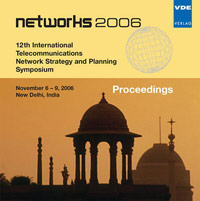Maintenance Activities, Operations and Environment Conditions Impact on the Availability of Highly Reliable Optical Transport Networks
Conference: networks 2006 - 12th International Telecommunications Network Strategy and Planning - Symposium
11/06/2006 - 11/09/2006 at New Delhi, India
Proceedings: networks 2006
Pages: 7Language: englishTyp: PDF
Personal VDE Members are entitled to a 10% discount on this title
Authors:
Basch, Bert (Verizon Labs, Welham, MA, USA)
Mezhoudi, Mohcene; Chu, Chi-Hung Kelvin; Goudreault, Robert (Bell Labs Advanced Technologies, Lucent Technologies, Holmdel, NJ 07733 USA)
Abstract:
The high dependency of modern daily life activities on fast and efficient communications means created a formidable demand for bandwidth on telecommunications Service Providers optical networks over the past decade. The concern for high availability and security of optical networks became rapidly a major factor in the architecture, design, deployment, and operation of these networks. Dedicated traffic routing protections schemes such as ring protection and (1+1) mesh protection have been the sole methods used to provide highly reliable networks. However, capital expenditure constraints and better utilization of network resources while keeping high availability, compelled network planners and designers to thoroughly assess network reliability for various design and protection options and make smart and appropriate decisions on network architecture and design solution selection. The reliability performance of SONET/SDH ring network has always been used as a point of reference against other network architecture alternatives because of its high reliability and self-healing capability. However, there has not been any consistent quantitative evaluation technique and metrics for the measurement of the reliability performance of various ring architecturesMany papers have been published in providing a detailed representation of the ring networks including the effects of various protection schemes. However, their models assume optical networks with smaller rings, relatively short links, and homogeneity (same nodes equipment and same distance from each node), the conclusions obtained are general in nature and may not be applicable to real ring or mesh networks, as demonstrated in this paper The primary objective of this paper is to apply a new framework for integrated reliability based network design to actual highly reliable network architectures (4-Fiber BLSR/DWDM architecture and (1+1) DWDM mesh architecture) using a hybrid technique that combines both analytical and simulation methods. This approach provides a comprehensive means to model and quantify the impacts of various network elements, operating conditions and protection schemes on the optical network availability and reliability. The network elements are modeled based to their actual configurations. Multiple ring and mesh network designs solutions are generated and their end-to-end reliability calculated. We then concern ourselves with the environmental effects by varying the rate of possible fiber cuts on the fiber links. In addition, we increase the frequency of fiber cuts when there is lack of route diversity. Network maintenance and operations practices effects on the networks availabilities are introduced via the variation of the frequency and duration of the span/link switching outages. We increase span/link switching outages when maintenance activities on the network links and nodes are intensified and more frequently required. We analyze, evaluate, and compare the impact of the environment (fiber cuts), the networks operation conditions (span/link switching) and the maintenance (duration of span/link switching) on the availabilities of these highly reliable networks and their economics.


